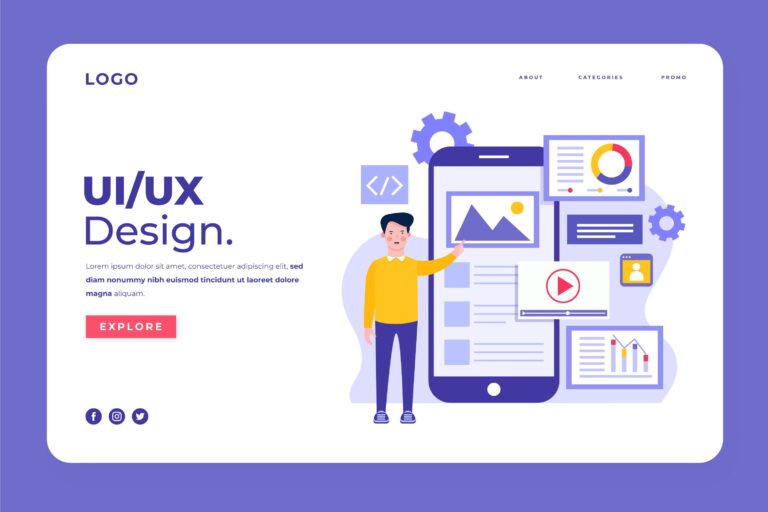Design and User Experience
- Mobile-Friendly: Ensure your website looks and functions well on all devices.
- Cross-Browser Compatibility: Test your site on different browsers for consistency.

Design and User Experience
Responsive Design
- Mobile-Friendly: Ensure your website looks and functions well on all devices.
- Cross-Browser Compatibility: Test your site on different browsers for consistency.
Fast Loading Times
- Optimize Performance: Use tools like Google PageSpeed Insights to improve site speed.
- Efficient Coding: Minimize the use of heavy scripts and plugins.
Clear Navigation
- User-Friendly Menus: Organize your navigation menu logically for easy access to all sections.
- Breadcrumbs: Implement breadcrumb trails to enhance navigation and SEO.
Professional Aesthetics
Design and User Experience (UX) are closely related but distinct fields that are essential for creating products that are both visually appealing and functional. Here’s an overview of both concepts and how they intertwine:
1. Design (UI – User Interface Design)
Design refers to the visual aspects of the product or interface. This is the part that users see and interact with. Key elements of design include:
Visual Aesthetics: The overall look and feel of a product. This includes colors, typography, layout, images, icons, and branding. Good design helps establish an emotional connection with the user and conveys the brand’s personality.
Layout and Composition: How elements are arranged on the screen. This influences how easily users can find information, navigate, and interact with the product.
Consistency: The visual elements should be consistent throughout the product. Buttons, icons, colors, and fonts should follow a design system to help the user predict what will happen when they interact with elements.
Responsiveness: How the design adapts to different screen sizes (like mobile, tablet, desktop). This ensures a good user experience across devices.
2. User Experience (UX)
User Experience focuses on the overall experience a user has with a product, system, or service. UX goes beyond just the look and feel (UI); it involves everything related to how a user interacts with and feels about the product. Key components include:
Usability: Ensuring the product is easy to use, intuitive, and that users can achieve their goals efficiently and effectively.
Functionality: UX ensures that all features of the product work as intended and provide real value. It’s about delivering solutions to user needs in a seamless and coherent manner.
Interaction Design: How users interact with the system, including the flow of actions, such as clicks, gestures, or voice commands, and the feedback they receive.
User Research: UX involves deep understanding of the target audience through research methods such as surveys, interviews, usability testing, and analytics. This helps designers create products that cater to user needs and behaviors.
Accessibility: Ensuring the product is usable by people with disabilities. This involves designing with accessible color schemes, ensuring screen readers can interpret content, and making sure all interactions are keyboard and mouse friendly.
Emotional Experience: A key part of UX is crafting an experience that makes users feel good about using the product. This can be achieved through a combination of smooth interactions, fast performance, satisfying visuals, and a clear understanding of user needs.
The Relationship Between Design and UX
Design as a Subset of UX: User Interface (UI) design is a subset of User Experience (UX) design. While UI is concerned with the visual and interactive design elements, UX focuses on the broader user journey and how these elements work together to meet the user’s needs.
Feedback Loop: Great design is informed by UX research, and UX is enhanced by good design. For example, a visually stunning design can enhance a user’s emotional connection to the product, but poor functionality will cause frustration and disrupt the overall experience. Conversely, a product with great functionality and usability but poor design may lack user engagement.
Holistic Approach: Both fields should work together to create a seamless experience. A product that looks beautiful but is difficult to use will result in a negative user experience. Similarly, a product with good usability but unattractive design may not be engaging enough to keep users coming back.
Key Best Practices for Excellent Design and UX
User-Centered Design: Always keep the user’s needs, preferences, and limitations at the center of the design process.
Simple and Intuitive Navigation: Ensure that users can navigate easily and find what they need with minimal effort.
Consistency and Familiarity: Maintain consistency in design elements, and use patterns that users are familiar with (e.g., the standard placement of navigation bars, icons, or buttons).
Effective Feedback and Responsiveness: Provide feedback to the user when they interact with elements (like animations, sounds, or messages) to confirm actions or show progress.
Accessibility: Ensure the product can be used by everyone, including those with disabilities, by following guidelines like WCAG (Web Content Accessibility Guidelines).
Continuous Testing: Conduct regular usability testing, analyze user behavior, and make iterative improvements based on feedback and data.
3. The Design Process in UX/UI
The Design Process for creating great user experiences typically involves several stages, which are iterative and may repeat as new insights or improvements arise.
1. Discovery Phase (Research & Strategy)
User Research: The first step in any design process is understanding the user. This can involve a combination of qualitative and quantitative methods:
- Interviews: Talking to users or potential users to gather insights into their challenges, needs, and preferences.
- Surveys: Collecting feedback from a larger audience to identify common patterns and behaviors.
- Analytics: Examining current user data to understand their behavior, preferences, and pain points.
- Personas: Developing fictional, generalized representations of your ideal or typical users to guide design decisions.
Competitive Analysis: Understanding how competitors or similar products are solving the same problems helps in identifying areas for improvement or differentiation.
Market Research: Evaluating the market to understand the business goals, brand positioning, and potential opportunities.
2. Ideation Phase (Concept & Wireframing)
Brainstorming: In this phase, designers explore a variety of ideas and potential solutions, often working closely with stakeholders to generate concepts that align with user needs and business goals.
User Flows: A diagram that visualizes the steps a user would take to complete a specific task. This helps ensure a seamless, logical progression from one step to the next.
Wireframes: Low-fidelity sketches or digital layouts that outline the structure of the product, focusing on functionality and layout without the distraction of color or design details. Wireframes are a great way to visualize the basic layout and interaction flow before adding design complexity.
3. Prototyping Phase (High-Fidelity Prototypes & Interaction Design)
Prototypes: Designers create interactive, clickable models of the product using tools like Figma, Sketch, or Adobe XD. These prototypes allow users to interact with the design and provide feedback before development begins. Prototypes range from low-fidelity (mockups or sketches) to high-fidelity (close to the final design).
UI Elements: At this stage, the actual design components come into play — colors, typography, iconography, buttons, navigation, images, and visual hierarchy. The goal is to create a visually engaging and intuitive interface.
4. Testing Phase (Usability Testing & Feedback)
Usability Testing: The key here is to test the prototype or product with real users. This can be done through:
- Moderated Sessions: Direct observation where users complete tasks while talking aloud about their thought process.
- Unmoderated Sessions: Users complete tasks on their own, and designers observe through recorded data or videos.
A/B Testing: Testing two versions of a design to determine which performs better based on user engagement, conversion rates, or other metrics.
Feedback Loops: Collecting and analyzing feedback from real users to make improvements. This phase ensures the product is fine-tuned to user expectations and preferences.
5. Implementation Phase (Development & Launch)
Collaboration with Developers: Once the design is finalized, UX/UI designers collaborate with developers to ensure that the design is implemented accurately and functions as intended.
Handoff Tools: Design tools like Figma, Sketch, or Zeplin are often used for an efficient handoff between design and development teams, ensuring that developers understand the design specifications, including measurements, font sizes, color codes, and spacing.
6. Post-Launch & Iteration
Monitoring: After launch, UX/UI designers and teams analyze how users interact with the product to detect any usability issues or areas for improvement.
Continuous Improvement: Using user feedback, analytics, and behavioral data to improve the design, features, or overall experience. This iterative process is key to long-term success.
4. Trends in Design and UX
The field of design and user experience is constantly evolving, driven by technology, user expectations, and design principles. Here are some current trends:
1. Microinteractions
Microinteractions are subtle design features or animations that guide users through tasks. They are typically used for:
- Button animations or hover effects
- Notifications or status updates (e.g., “saved,” “loading,” etc.)
- Providing feedback when users perform actions (like a heart animation when liking a post) These small details improve user satisfaction and make an interface feel more polished and responsive.
2. Dark Mode
Dark mode has become a popular design trend in recent years. Many users prefer it for its reduced eye strain, especially in low-light environments. It’s important to ensure that dark mode doesn’t compromise legibility or accessibility.
3. Voice User Interface (VUI)
With the rise of voice-activated devices (like Alexa, Siri, and Google Assistant), VUI design is becoming an integral part of the UX. Designing for voice means considering conversational flows, natural language processing, and how users interact through speech.
4. Personalization
Personalized experiences enhance user engagement. Websites and apps can leverage user data to customize content, product recommendations, and even interface layouts. Personalization can be based on factors like location, behavior, or preferences.
5. Augmented Reality (AR) and Virtual Reality (VR)
AR and VR are increasingly becoming important in user experiences, particularly for eCommerce, gaming, and education. Users can interact with 3D elements or immersive environments, making their experiences more engaging and interactive.
6. Accessibility-first Design
Designers are increasingly prioritizing accessibility to ensure that products are usable for people with disabilities. This includes features like:
- Text-to-speech and speech-to-text
- Keyboard navigability
- Color contrast adjustments
- Customizable UI for those with visual impairments
7. Minimalist and Flat Design
Flat design eliminates unnecessary details and focuses on clean, simple elements. Minimalist design follows a similar principle, but with even fewer elements, often stripping away anything non-essential to focus on the core user experience.
8. Data Visualization
As users are becoming more data-savvy, the ability to present data clearly and intuitively is important. Interactive charts, infographics, and other data visualizations are becoming more prevalent to help users quickly understand complex information.
5. Key UX/UI Tools for Designers
Here are some of the most popular tools designers use for creating stunning user experiences:
- Figma: A collaborative design tool for creating UI, prototyping, and wireframing, popular for team-based design work.
- Adobe XD: Used for wireframing, prototyping, and visual design, with a focus on UI/UX design.
- Sketch: A vector-based design tool often used for UI design and prototyping, especially for macOS users.
- InVision: A tool for creating interactive prototypes and collaborating with team members during the design process.
- Axure RP: Known for its powerful prototyping capabilities, used for more complex interactive prototypes and wireframes.
- Balsamiq: A rapid wireframing tool used for low-fidelity wireframes and sketches.
6. Key Principles of Great UX/UI Design
- Simplicity: Less is often more. Keeping the design clean and intuitive helps users focus on their tasks without distractions.
- Hierarchy: Organizing elements based on importance, ensuring users understand what they should focus on first, second, and so on.
- Clarity: Every interaction should be straightforward, with clear labels, instructions, and feedback.
- Efficiency: Minimizing the steps or actions required to complete tasks makes for a smoother user experience.
- Empathy: Understanding users’ emotions, challenges, and goals ensures that the design truly resonates with them.
Final Thoughts
Great Design and UX go hand-in-hand in crafting experiences that are not only aesthetically pleasing but also functional, intuitive, and human-centered. The design process is iterative, with constant learning from users, adapting to new technology trends, and refining the product to meet evolving user expectations. By focusing on both the form (design) and the function (experience), designers create products that feel seamless, engaging, and valuable.

